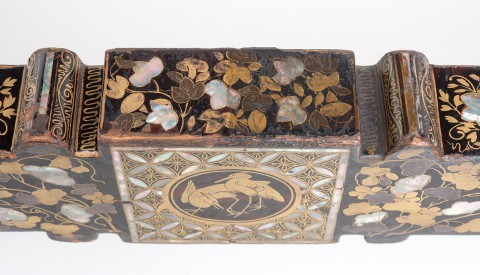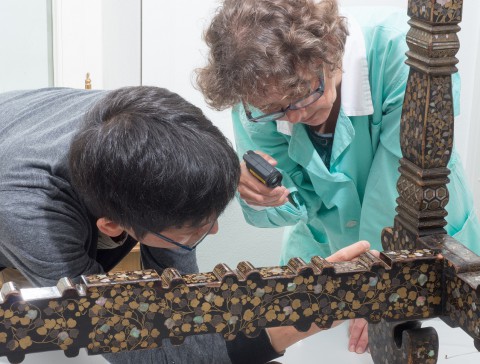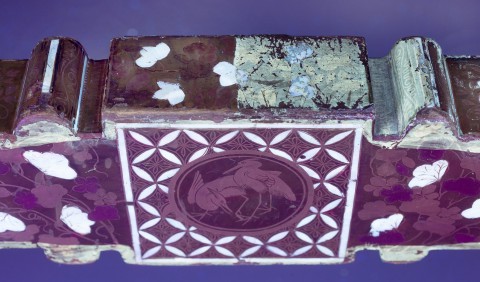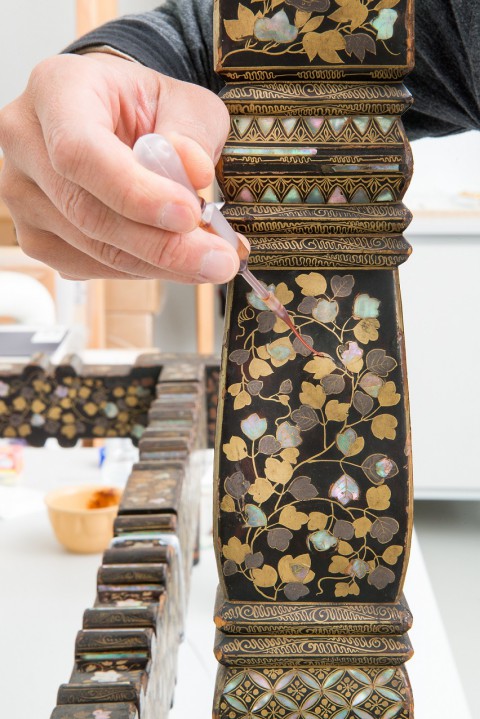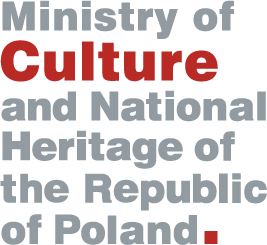Conservation of a unique Nanban table from the Wilanów collection
Thanks to the financial support from the Japanese Sumitomo Foundation and cooperation between the Museum of King Jan III’s Palace at Wilanów with outstanding experts in Asian lacquer, it was possible to take the conservation works of the Nanban style seventeenth-century table in the Wilanów collection. It was one of the first conservation projects involving both Japanese and European specialists. It was part of cooperation started in the 1990s and involving science and conservation, between Japan and world institutions that keep in their collections artworks decorated with Oriental lacquer – unique witnesses of early modern contacts between East and West. Owing to exchange of experience and expertise, a strategy for the preservation of those very fragile Oriental artefacts has been devised.
A high table dating from ca. 1610, finely adorned with precious ornaments, is one of such exhibits. Its decoration from lacquer, powdered gold, silver, and mother-of-pearl represents the Nanban style known from luxury objects, which were manufactured in Japan for export at the turn of the 17th century. The artworks were characteristic for a specific period and historical circumstances. In 1543, the Portuguese arrived in Japan for the first time, which marked the beginning of new direct trade exchange between the continents. That chapter in Japanese-Portuguese relations ended as early as the 1630s, when the ruling Shogun from the Tokugawa family decided to close the country to foreign cultures.
For a few dozen years, objects of everyday use aimed to serve Europeans and to suit their tastes were manufactured in Japan. Initially, the Jesuit missionaries commissioned such objects from local artists, because they needed religious utensils suitable for Christian religion and thus unavailable in Japan at that time. Therefore, they commissioned such works as decorated containers for the Host, lecterns to support the Bible, adorned with Christian symbols, or portable altars. Most of those objects remained in Japan after the missionaries’ expulsion or death.
Another group of customers for Nanban works were the Portuguese who lived in Europe but became acquainted with exotic Asian crafts through Jesuit missionaries. They commissioned products which were sent to Portugal by sea.
This interesting story describing the origins of Nanban works is reflected in their form. They are decorated using traditional Japanese lacquer by applying thin layers of natural resin extracted from lacquer trees (Rhus verniciflua). Every layer must be hardened and polished. Japanese lacquer trees must be at least ten years old and lacquer is extracted only once. Around 150 millilitres of lacquer can be extracted from one tree, and then the tree dies. Therefore, it is clear that Japanese lacquer is a very precious material. Extracting lacquer from Chinese trees is a little different, as they regenerate after the loss of resin and lacquer can be extracted several times.
Natural drying plant oil may be added to resin. The amount of oil influences the durability and plasticity of lacquer. Its Chinese variety to which more oil is added shows high plasticity, and it is applied using thicker layers than in Japan, and often moulded in sculptural forms. Traditionally in Japan, none or very little oil was added to lacquer. However, probably because of the fact that manufacturing products for European customers had to be done quickly, Nanban lacquer contains much more oil, so less layers could be applied to achieve a shining effect. Unfortunately, the hastiness of the manufacturing process affected the durability of decorations of artefacts commissioned by the Portuguese in Japan. Owing to a large amount of oil added to successive layers, the lacquer soon looked as shiny and impressive as required. However, later it turned out that, if that technique was used the material quickly deteriorated. The lacquer was less resistant and more light sensitive. Micro-cracks soon appeared in its surface, which in turn blurred its original dark colour and characteristic shine. What is more, the oil also permeates the lower layers and so the base might also deteriorate.
It needs to be stressed that Oriental lacquer differs from its European variety by the type of material used. The true lacquer hardens irreversibly under the influence of humidity and oxygen, whilst lacquers based on natural resins (e.g., shellac, mastic, or sandarac) are soluble. They are used, for example, in India or to obtain a European imitation of lacquer.
Elegant dark lacquer is adorned by contrasting mother-of-pearl and gliding. In the case of Nanban objects, such decorations also originate from the repertoire of traditional Japanese motifs, i.e. fantastic creatures present in Japanese mythology and sculpture, or plants known from traditional Oriental lacquer, whilst the composition of such elements are unknown to earlier Japanese art. Nanban decorations densely cover every inch of the surface of such export masterpieces, which is probably due to requests in European orders which Japanese artists followed. The contracting parties wanted abundant decoration, foreign to Eastern tradition, so they received what they wanted – but composed from Asian iconographic motifs.
In view of the specificity of monuments of Oriental art, for some time, a debate has been held in Europe on the methods of conservation of those extraordinarily fragile objects. The methods of dealing with missing parts and micro-damages that have been developed in Europe involve the use of synthetic resins and natural solvents. Therefore, in line with the most important rules of contemporary conservation, intervention is reversible, because such resins react to solvents. However, critics of that method argue that adding resins used in European lacquer to the traditional Japanese technique is inadequate and harmful.
Opting for Japanese methods of conservation in which only resin from lacquer trees (urushi) for centuries serving to manufacture decorative lacquer – also in the Nanban type – is used may be an alternative. The adequacy of materials is a great asset in this case; however, the irreversibility of that method is rather controversial, as it disagrees with the principles adopted by conservators’ organizations in the 20th century. It needs to be noted that the Japanese Ministry of Culture gives the conservators precise instructions on how to deal with items in which Oriental lacquer was used: Only the use of urushi resin is acceptable and conservation must be limited to preservation treatment.
In the late 20th century, European and American conservators began to consider Eastern methods of preservation of lacquer more seriously. However, until the 1990s, there had been no professionals who would be able to carry out conservation following Japanese guidelines. Thanks to museum specialists from Cologne, cooperation with conservators from the East began. Scientific conferences on conservation methods were held in Japan, while at the same time presentations of renovation of objects preserved in the West were held in Europe, and conservators could observe Eastern methods at work.
The Cologne experience was also adopted by Bavarian museums, which focused on research work. Also the Victoria & Albert Museum in London organised the first international conservation project coordinated by the Shayne Rivers team. Since that time, more and more conservators and researchers have supported traditional Eastern methods of the conservation of Oriental lacquer. The American Getty Institute also has greatly contributed to the cooperation.
After lengthy discussions, analysis of the literature on the subject, and the first conservation projects in European collections, the Museum of King Jan III’s Palace at Wilanów also decided to choose the Japanese technique for the conservation of the unique Nanban table. The most prominent Japanese specialist in lacquer and mother-of-pearl conservation, Mr Shigeru Kitamura, has been invited as consultant. Ms Joanna Koryciarz-Kitamikado, an outstanding specialist in conservation of Oriental lacquer, was also invited to cooperation. The proposal of renovation work was submitted to the Japanese Sumitomo Foundation, which allocated a substantial grant to the project, which received support from two renowned specialists in oriental lacquer – Ms Masako Shono-Sladek, Curator from Museum für Ostasiatische Kunst in Cologne, and Ms Monika Kopplin, Director of Museum für Lackkunst in Münster. In this way, the work on the masterpiece kept in Wilanów became the second international Japanese-European conservation projects.
The project is of great importance, not only in view of conservation methods and specialists involved, but also because of the uniqueness of the artefact itself. The Wilanów table made in Japan ca. 1610 is a world unique exhibit of this size. The piece of furniture is in the style of the Portuguese dinner table, but it was manufactured and adorned in Japan. The Wilanów collection acquired it in the mid-19th century, and it was probably purchased by August Potocki. It was first mentioned in the inventory books in 1867.
Since that time, the table was in use, subject to various conservation processes and covered with wax. After changing fortunes, the very fragile exhibit required serious conservation. The decoration was unstable, threatened with a loss of small elements, and the traces of earlier use were visible, in particular, on the legs. A closer look by conservators showed secondary layers of early modern varnish, numerous missing fragments of mother-of-pearl decoration, repainting, lacquer cracking caused by photo-degradation and lacquer delamination. The original gilt decorations were strongly worn off and painted over in many places. The colour of the table was devoid of its original intensity and lustre, but it could be admired on the sites that for centuries were hidden under more modern varnish. When the layer of varnish was removed, one could see small fragments of unaffected lacquer, very dark and shiny. We can assume that this is how the entire table originally looked.
Detailed photographic and photogrammetric documentation as well as research were carried out prior to starting conservation work. The research work was coordinated by Ms Anna Guzowska of the Wilanów Museum. She attended a symposium on Nanban art in Tokyo and a RAdICAL workshop in Amsterdam, where the samples of lacquer were subject to chemical analysis, including samples taken from the Wilanów table. It turned out that, in this case, a very high amount of oil extracted from perilla had been added. This resulted in the strong photo-degradation seen on the surface but also the weakening of the base material. One could see that lacquer flakes off together with the base here and there.
Then Mr Shigeru Kitamura came to Warsaw on a study visit to consult the first more detailed conservation assessment of the table’s condition. Based on chemical examination, he re-created on test beds the base and lacquer layers applied on the Wilanów table on test beds.
Mr Kitamura supervised the entire conservation process and within two years checked the quality of its subsequent stages four times. He also gave invaluable advice and personally did the work on the most difficult pieces of decoration. The entire table surface was cleaned several times. Not only surface dirt was removed, but also waxes, secondary lacquers, putties and varnishes, as well as faulty reconstructions that largely covered the original. Special precision and precautions were needed to carry out the work. The tiniest detached fragments were carefully placed (appropriate glues were selected by Mr Kitamura), using a wooden frame – shimbari. During the works, it turned out that most of the pearl tiles were more or less movable, and gluing often had to be repeated. In many places lacquer detachment also occurred. They were fixed with a special glue with lacquer.
Then the loses in places of uncovered wood were filled with kokuso putty. Where mother-of-pearl elements are lost, they will not be reconstructed. A band made from a mass that contains lacquer reinforced the edges created in the process to protect them from forthcoming destruction. The entire surface several times was saturated with fresh lacquer that filled in the micro-cracks. The process named urushigatame restored the table to its former splendour to a large extent. It was also protected against further destruction.
Currently, this priceless artefact is presented in a specialist showcase that protects it against changing climatic conditions and destructive light, while also allowing our guests to admire the work and get to know the details as closely as possible. The construction of the showcase has been financed by the Ministry of Culture and National Heritage's subsidy.
suggested

International Conference "Nanban. Far East. Close Art", 4-5 October 2019
On October 4–5, 2019, the Museum of King Jan III's Palace at Wilanów hosted the International Conference “Nanban. Far East, …

Nanban-type table
Nanban, or the “art of the southern barbarians”, denotes sixteenth- and seventeenth-century Japanese works of decorative art, reflecting a discernible …

New exhibition at Chinese Cabinets – restoring the memory of the collections of Stanisław Kostka Potocki and his descendants
In 2019, a new exhibition commemorating the collector's passions of Stanisław Kostka Potocki and his descendants was opened at the …


